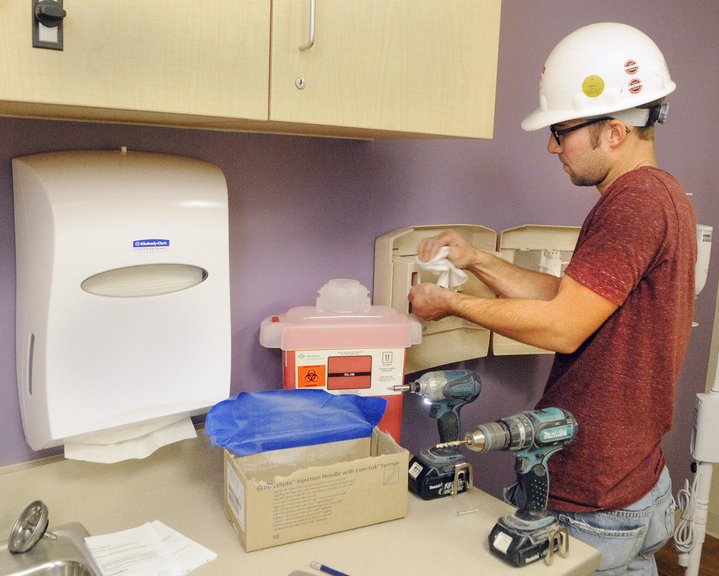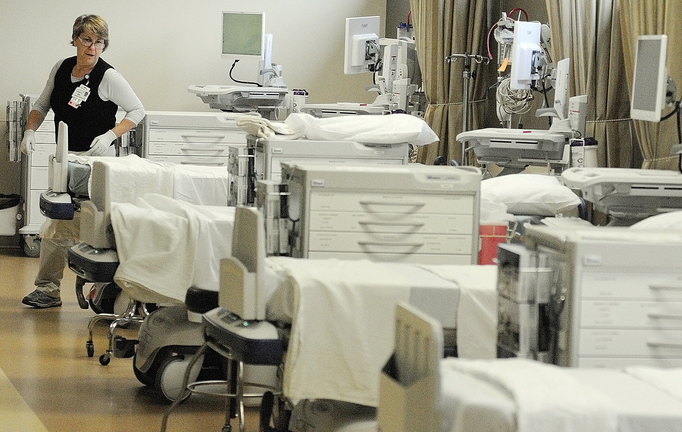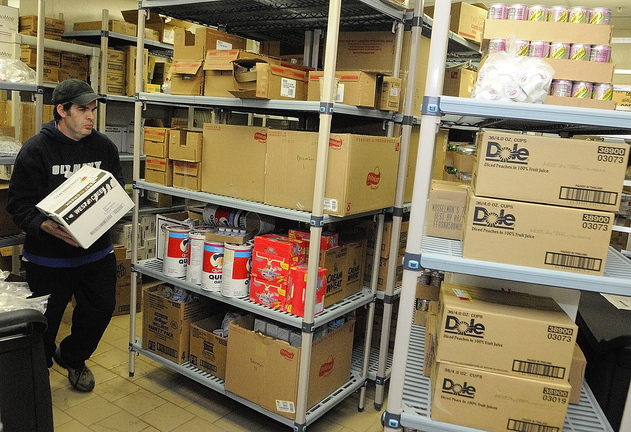AUGUSTA — Except for the occasional “facility closed” sign outside, the new Alfond Center for Health on Friday appeared to be open.
Two people walked through the main lobby wearing the green surgical scrubs and hairnets, signaling that they’re operating room personnel.
Others pushed carts loaded with supplies. Computer monitors were up and running, and people could be seen working at their desks on the second floor of the glass-walled education pavilion.
A number of vehicles filled slots in the main visitor/patient parking lot as well as the employee lot, and couriers hurried into the building with deliveries.
The atmosphere was full of expectation as MaineGeneral Medical Center prepared for today’s opening of its new 192-bed community hospital. The $312 million facility combines the inpatient beds of the Thayer Center for Health in Waterville with all the functions of the hospital on East Chestnut Street in Augusta.
“This is a very exciting time for us,” said Chuck Hays, chief executive officer of the hospital’s parent corporation, MaineGeneral Health, at a pre-move press conference Friday at the new hospital. He talked about the decade-long effort to reach this point. “The vision was to create the best community hospital in the state known for uncompromising excellence.”
Move preparations have been underway for about 20 months, assisted by Ann Ahmadi, project manager for HTS, Inc., of Emeryville, Calif., which specializes in hospital moves. Hays said Ahmadi reminded officials it was same length of time as the gestation period of an elephant.
In keeping with that analogy, Hays said, “We’re ready to give birth.”
The process was to start at 6 a.m. today with the closing of the emergency room on East Chestnut Street and the opening of the emergency room at 35 Medical Center Parkway on Old Belgrade Road near Interstate 95’s exit 113.
Some 16 ambulances were scheduled to move patients to the new facility beginning at 7 a.m., and plans called for each patient to be accompanied by a nurse, a paramedic/EMT, and some specialty technicians or physicians if necessary.
Two dozen nurses who work at the adjacent Alfond Center for Cancer Care — which is closed during the weekend — were recruited to do the ambulance runs with the medical/surgical patients. “The goal is to have all patients moved by 5:30 p.m.,” said Sherri Woodward, senior vice president for patient services and chief nursing executive.
Nurses from the critical care, labor and delivery, and pediatric units will be traveling with their respective patients.
While some of the estimated 150 patients might also be accompanied by a family member, the new hospital is not open for visitors until about 6 p.m. when the transport is expected to be complete.
Hospital officials asked that people stay away while the move takes place to ensure patient safety and privacy and to avoid delaying the process. Hays said the hospital had to double its number of stretchers to keep the process moving since each has to be thoroughly disinfected between runs.
The Thayer Center for Health will remain open as an outpatient facility with a 24-hour emergency department, and a $10-million improvement project there starts Monday.
But the East Chestnut Street hospital in Augusta will close Saturday. Hays said it will be emptied and cleaned before being turned over to its new owners in January, although the hospital will continue to lease a portion of it.
On Friday, MaineGeneral Medical Center Chief Operating Officer Paul Stein walked through the halls of the new hospital, explaining that the gowned, operating room personnel were checking to be sure the surgical supplies were fully stocked because operating rooms will be open at 6 a.m. for emergency surgery.
Hays, Stein, and other hospital officials will be at the new building starting at 4 a.m.
“It’s so exciting, so you don’t get tired,” Stein said. The cafeteria too opens at 5 a.m. for staff. Officials said personnel who were not asked to work opening weekend were disappointed, but reminded that fresh eyes are needed Monday.
Ahmadi said her company has moved dozens of hospitals over the past seven years, but works on more than just moving logistics.
“We really help facilitate learning to live in their new facility,” she said. “The construction people focus on the building; what we focus on is bringing the building to life.”
In turn, that improves patient care, Stein said.
Stein said the staff members from both Augusta and Thayer hospitals have worked together over the past year and concentrated on improving work flow.
Part of that included setting up the three stories of the west patient tower so that each medical/surgical unit is identical and all the same supplies and equipment are in the same place.
“Standards and sticking to a particular process are what really help to improve the quality of care,” Ahmadi said.
The other patient tower contains critical care rooms on the first floor, and maternity and pediatrics on the second. Rooms for patients receiving mental health and substance abuse services are in the south end of the building.
The hospital was erected to keep public areas and access via a main corridor that serves as a spine on the “front of the house” and runs to the patient wings. Labs, surgical areas and in-patient services area at the rear, which has a separate, limited access corridor. Hays estimated 1,700 people will work at the new hospital although not all will be full time.
Some construction workers will remain on hand for opening weekend to make last-minute adjustments, Stein said. Also, the single-story construction trailer complex, known as the COLO, which sits near Old Belgrade Road between the new hospital and the cancer center, will be removed in December and the ground will be seeded next year.
Along with all the new equipment, the hospital will offer valet parking for patients and visitors during the day Monday through Friday. However, parking should be less of a problem at the new facility, Stein said. “There are more spots closer to the building than at our other campuses, including Thayer,” Stein said.
Michael Koziol, MaineGeneral’s chief financial officer, said the hospital is saving some money on construction costs but continues to project a loss, much of it related to the costs of opening the new hospital and continuing to occupy both the former Seton hospital in Waterville and the Augusta building. Koziol said the hospital will take much of the hit this fiscal year rather than next, when it was originally planned to open, but hopes to move toward breaking even and then into the black.
MaineGeneral put out nearly $281 million in bonds in 2011 to finance its new hospital. “People who hold those bonds expect to make profits,” he said. “We have to pay back the bond holders.”
Eight weeks ago, Moody’s Investors Service, which rates bonds, downgraded the hospital’s rating to Ba1, the highest in a tier of ratings applied to bonds that are “considered speculative and are subject to substantial credit risk.”
The entire hospital project, including financing, is estimated at $412 million and includes the $10 million in improvements at the Thayer Center.
Betty Adams — 621-5631badams@centralmaine.comTwitter: @betadams
Send questions/comments to the editors.







